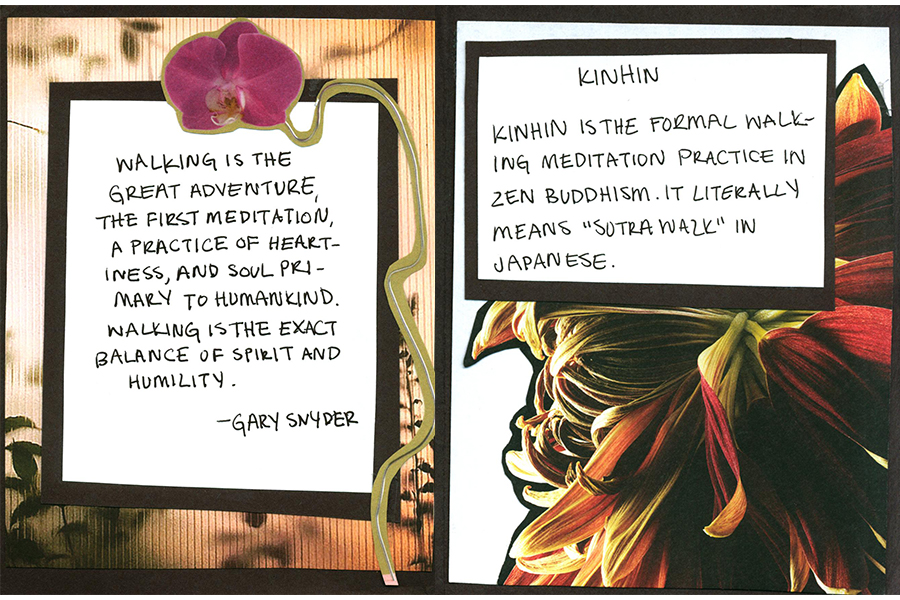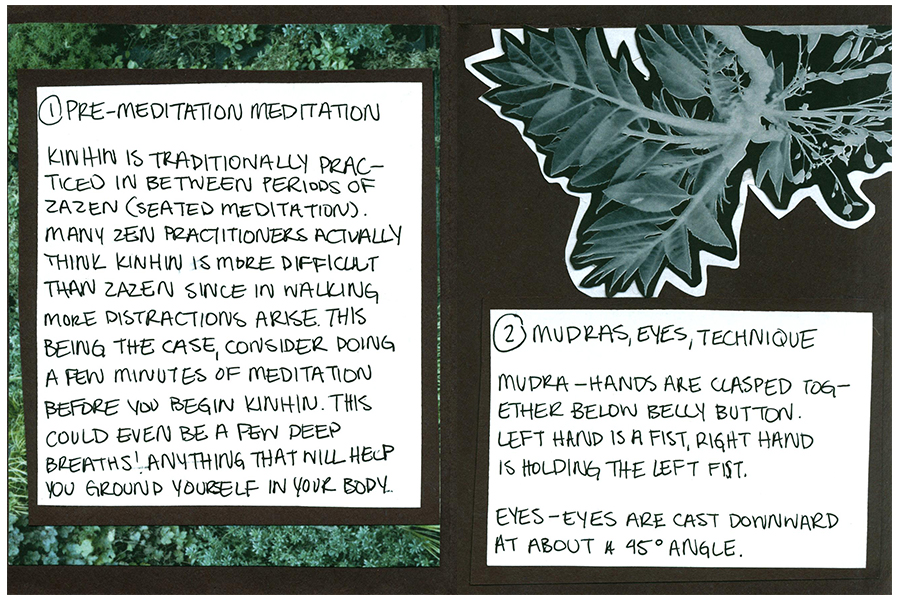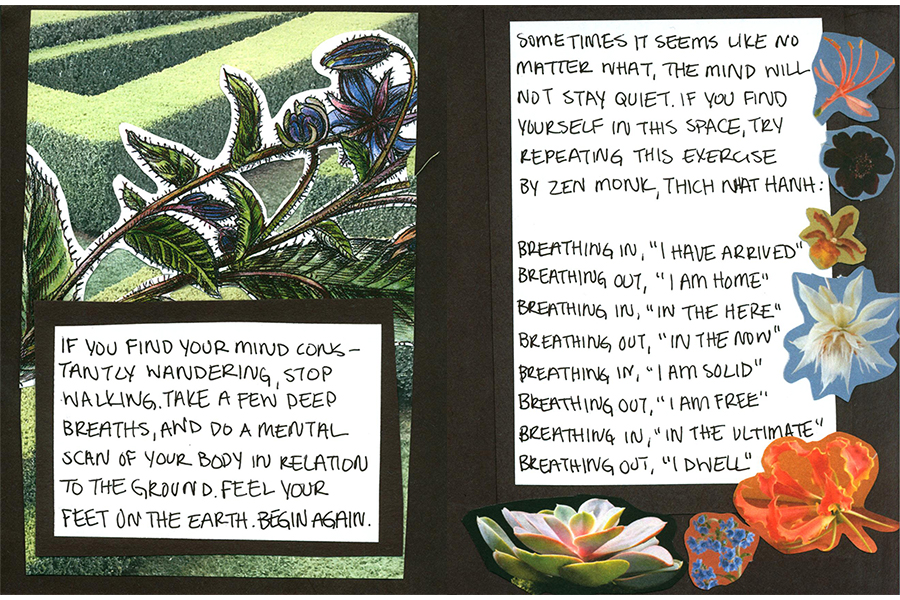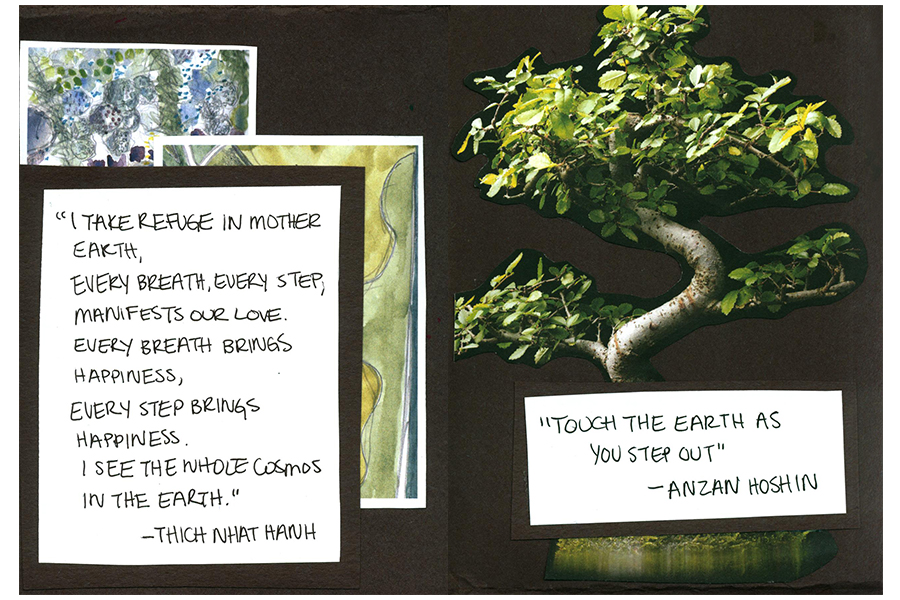A brief introduction to the traditional Zen Buddhist form of walking meditation in the form of a zine.
Kinhin
kinhin is a short, 14-page zine I created to provide a brief introduction to the traditional Zen Buddhist form of walking meditation. Though kinhin may be practiced outdoors, it is often practiced inside a zendo or other meditative hall. In light of Professor Meredith Theeman’s course “A Walk in the Woods,” I wanted to create a project that specifically focused on kinhin as an outdoor walking meditation experience.
kinhin is a rather personal project, for it combines my own experience with Zen Buddhist walking meditation with the experiences I collected this semester charting my own walking as a class exercise. At the beginning of the semester, I found that nearly all of my walks were accompanied by some form of audio provided to me through my earbuds. Even when I intentionally set out on a more meditative walk to clear my head, I found myself needing to play music or listen to a podcast in what seemed an attempt to tune out the noises of the city and perhaps my inner monologue. When I was made aware of this habit through having to document my walks for class, I made a conscious decision to begin taking some of my walks in silence. When I became forced to listen to the sounds of the city—some pleasant and some very unpleasant—I found practicing certain walking meditation techniques to be quite helpful. Additionally, it made me realize how walking in the city is not a dissimilar experience to walking in the zendo or any other quiet, reflective space, if one makes a conscious effort for it to be.
That being said, I think it is perhaps a difficult task to jump right into walking meditation in a city without having tried any sort of walking meditation in a space more conducive to the practice. “Thich Nhat Hanh on Walking Meditation” was the text from which I primarily drew in the creation of the zine. Nhat Hanh has a great gift for creating mantras that one can hold onto during meditation. For walking mediation he suggests matching each in-and-out breath with particular phrases like “I have arrived” or “I am home” that emphasize the connection between the individual doing the meditation and the ground on which they stand.1
Nhat Hanh’s philosophy on walking meditation draws specifically on humanity’s relationship to the earth. In addition to the explicit physical activity that is walking, the course texts have also focused on a variety of different relationships one might have with the natural world. In A Walk in the Woods and On Trails, both Bill Bryson and Robert Moor mention how common it is for people in the midst of distressful life situations to decide to undertake the Appalachian Trail. Even in 1862, Henry David Thoreau was writing about his own kind of sublime experience achieved through simply walking through the woods not far from his home. He writes in his famous essay “Walking” that “I enter a swamp as a sacred place, a sanctum sanctorum. There is the strength, the marrow, of Nature. The wildwood covers the virgin mould, and the same soil is good for men and for trees.”2
These various writers and thinkers all recognize the existence of a profound connection between the act of walking, specifically in what we refer to as “nature,” and the state of one’s spirit and mind, or what some might call a soul. I thought that through the creation of kinhin I might be able to provide a brief introduction to the reader on how to potentially begin, or continue, to foster their own profound connection to the earth. The zine itself opens with a quote from one of my favorite poets and environmental thinkers, Gary Snyder. It is taken from his book The Practice of the Wild, in which he writes, “Walking is the great adventure, the first meditation, a practice of heartiness and soul primary to humankind. Walking is the exact balance of spirit and humility.”3
This zine imparts no ultimate “goal” on the reader, as I wanted kinhin to embody the freedom of Zen practice, which I interpret as a rather fluid philosophy that is adopted a bit differently by each of its practitioners. Because it is an instruction manual to some degree, it was important to me to include quotes like Snyder’s and Nhat Hanh’s so as to provide relief from the step-by-step guide and get a bit more to the heart of the practice. In the zine, I also hope to strike a balance between offering information and suggestions in order to facilitate the clearing of the mind, and yet also hopefully communicate that judging your practice is not necessary. It is, after all, called a “practice” for a reason. My hope was that kinhin could be a kind of small, special book that someone could keep in their bag and, perhaps, take on a walk.
- Thich Nhat Hanh, “Thich Nhat Hanh on Walking Meditation,” Lion’s Roar, January 11, 2018, www.lionsroar.com/how-to-meditate-thich-nhat-hanh-on-walking-meditation/.
- Henry David Thoreau, “Walking,” The Atlantic, June 1862, www.theatlantic.com/magazine/archive/1862/06/walking/304674/.
- Gary Snyder, The Practice of the Wild, (Berkeley: Counterpoint Press, 2010), 18.







